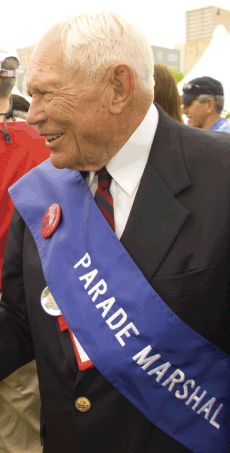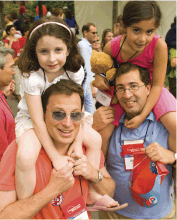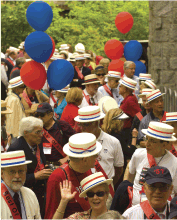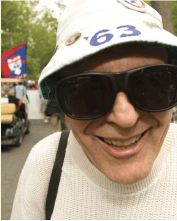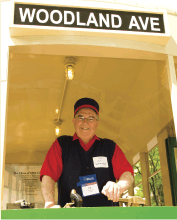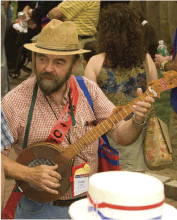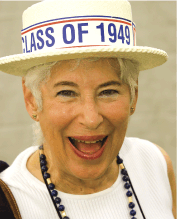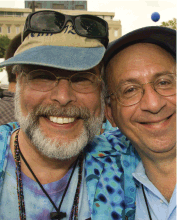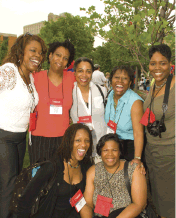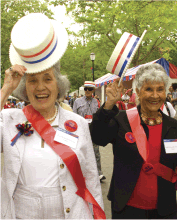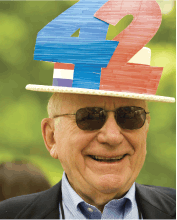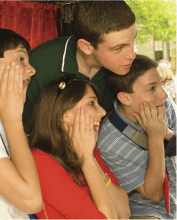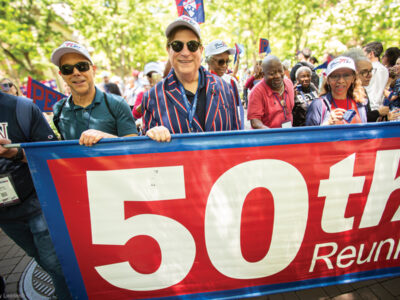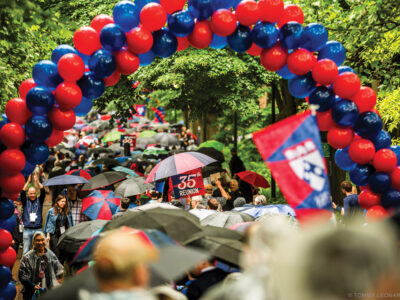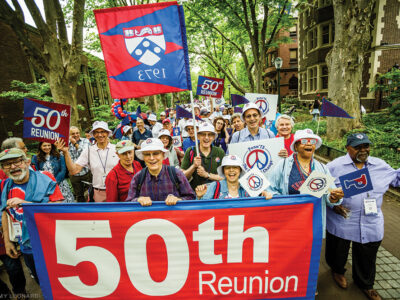Slideshow | Photography by Addison Geary
Food for Thought
The chance to catch up with old friends—and maybe make some new ones—will probably always be the biggest draw, but alumni who return to campus for Alumni Weekend can also find a lot more to interest, entertain, and enlighten them than picnics, parades, and parties. This past May, Penn Alumni and the University’s various schools and centers mounted dozens of panels and lectures that featured alumni and faculty discussing just about everything under the sun—which shone brightly for much of the weekend.
What follows is a small sampling of talks that were worth staying inside for.—J.P.
The Un-Spin Cycle
Dr. Kathleen Hall Jamieson, director of the Annenberg Public Policy Center, is no stranger to debates about political manipulations. The former dean of the Annenberg School for Communication has written such highly regarded analyses of the spinning landscape as Dirty Politics: Deception, Distraction, and Democracy; Packaging the Presidency: A History of Criticism of Presidential Campaign Advertising; and Eloquence in an Electronic Age: The Transformation of Political Speechmaking. In April, she and Brooks Jackson—the journalist with whom she founded the website FactCheck.org—published a new book: unSpun: Finding Facts in a World of Disinformation (Random House), whose own promotional literature pitches it as a “secret decoder ring for the 21st-century world of disinformation.”
On Friday afternoon of Alumni Weekend, Jamieson spoke about unSpun and offered “some cues to tell you when something is more likely to be factually problematic” to a group of alumni and other visitors in Van Pelt Library.
If you see an ad, and it’s scary, be wary. It’s not always true that scary ads are problematic. In fact, there are some things that we should be genuinely terrified about and the claims are absolutely accurate. In general, when you see wolves prowling around on screen, and they’re scary, and the [inter-cuts] show you a forest in half-light and now the wolves are scarier … In case you didn’t pick up that things are scary, then the music is scary—so scary music and scary wolves, scary inter-cuts, and now somebody says that John Kerry voted [in favor of] intelligence cuts after the first terrorist attack: Be wary. Because that’s literally true, but probably inferentially false if you hear about that after September 11 [because it actually refers to the 1993 attack on the World Trade Center]. Now, maybe you didn’t hear it that way. That would be good. But the Annenberg Public Policy Center runs the National Annenberg Election Survey, which is the largest survey done by an academic institution, and we know over half the electorate thought it was true that John Kerry voted for intelligence cuts after September 11.
Another test: If you think about it and it seems really implausible, it probably is. Let’s think about September 11. The towers had come down; Pennsylvania is frightened; Philadelphia is frightened; we don’t know whether we’re going to be next; the country is terrified. You think that anybody, even the person with the least common sense you’ve ever known, would then say, “You know, I’m going to go vote against intelligence. I’m going to vote for intelligence cuts.”? No! But you see, there never was a place you could have tested implausibility, because you didn’t actually go through a process of analytically accepting the claim. You were being scared, and the claim slid through … now those things come together and you’ve got a surprising amount of the electorate thinking something that wouldn’t make sense if you tested it through plausibility. They were scared, we were scared.
And you notice that they were scared? Well here’s another principle: We think they are vulnerable to deception, but we don’t think we are. As social psychologists have known for a long time … experts make all the same mistakes that non-experts make. We have the same cognitive mechanism. As a result, we’re supposed to make mistakes too. One danger is that we’re perfectly confident we’re invulnerable—and as a result, we are vulnerable.
Let me give you another principle I mentioned earlier: Language does our thinking for us. I’ve authored into the context of the scholarly debate about whether there is fact or not, but here is the broader truth underlying the fact that language does our thinking for us, and it certainly does when you’re dealing with political advertising and politics. We know for example that when you say intact dilation and extraction, it sounds like a medical procedure, it sounds like doctor talk, it sounds like something that experts in that area ought to make a decision about. You wouldn’t ordinarily make decisions about intact dilation and extraction. It’s expert language. But call it partial-birth abortion, and you’re now in a trajectory in which you’re far more likely to take one ideological position than another. It doesn’t mean that one is spinning and the other isn’t; language is inevitably creating our sense of reality …
We took on Bush with the wolves ad. Now we’re going to take on the Democrats with MoveOn.org. There was an ad put together by MoveOn.org and it showed a gun, an automatic weapon, and in the background of the ad you heard [she simulates gunfire] and it suggested that horrible things were going to happen because the assault-weapons ban had not been renewed. I have very intelligent, very well-educated friends who saw that ad and believed that the gun that was shown was going to be back on the streets as a result of the end of the assault-weapons ban … [But] the weapon they showed on the screen was already banned when the assault weapons ban came in and as a result was unaffected by it. I could make a plausible case for the assault weapons ban, even though it didn’t ban as many things as some people would have liked, but it’s very difficult when people assume that it did a lot of things that it didn’t do, to tell that that ad is frightening you in ways you didn’t need to be frightened. Maybe you should still be frightened about all this, but not based on that. Language tends to do our thinking for us. And we know people overgeneralize the scope of the assault weapons ban.
What politics has attempted to do since the beginning of politics is find labels that we’re willing to embrace, and attach them to things that they may not be legitimately attached to.—S.H.
New Suburb, Old Model
In his latest book, Witold Rybczysnki, the Martin & Margy Meyerson Professor of Urbanism at the School of Design and professor of real estate at Wharton, details the creation of a village-style suburban subdivision on old agricultural land in Chester County, Pennsylvania. One of the leading characters in Last Harvest: How A Cornfield Became New Daleville is real-estate developer Joseph Duckworth WG’72, whose firm led the project. On Saturday morning of Alumni Weekend, Rybczynski and Duckworth sat down to talk about why American suburbs look the way they do, and one trend that may change them.
DUCKWORTH: Real-estate developers, because we are change agents, and almost nobody wants change, tend to be terribly unpopular. So getting into this project, we decided to specialize in this little niche called New Urbanism … Although some people would argue that what we do is still conventional, it is on the complete cutting edge of profit-making development. What we try to do is figure out the place where the market will accept some of these new trends of smaller lots, walkable communities, infill, cluster, etcetera, and not just deal with McMansions on large acreage. The way we got to this site was that a rather conventional developer had purchased the site and filed a plan for it that was compliant with zoning. He showed it to the town, and the town said, “Oh my gosh. That’s not what we had in mind! It’s a terrible thing.”
Well, the developer said, “That’s exactly what your code calls for!”
“Yeah, but we don’t like it.”
“Well what do you want?”
“We want a village with sidewalks, and little lots, and parks, and a store you can walk to, an athletic field…”
“But that’s not in your code!” …
RYBCZYNSKI: We think of development as something done by the developer. What we forget, I think, and what gets left out of the equation, is that communities also create development, because communities decide that this site is going to be for housing, and this site is going to be for some other use-industrial use or agricultural use…
Who’s really to blame for sprawl and the kind of suburban development that we see? … The developer who builds is to blame in the sense that the developer and homebuilder are actually doing the work, but the decisions made by communities are very important. To the extent that new developments succeed or fail, I think a great deal of the responsibility really hangs with the citizens in those areas, because they are making decisions to protect themselves, they are sometimes making simply ill-informed decisions, they are sometimes making decisions to be popular with their neighbors. It’s a very democratic process, which is good, much more democratic than urban development … I think the interesting thing about suburban development is the communities are so small that everybody knows everybody, and the people sitting on this planning board are just five citizens and everybody in the audience knows them. They’re neighbors. The process is much more transparent than what you would see in a city, but it’s not always very logical. …
DUCKWORTH: We came out of a tradition, which kind of ended with World War II, of small-lot, walkable places with towns. I have a theory that during the Depression and World War II, very little housing was developed, so there was a time to shift and come up with a different approach. In the early ’50s, the Levittowns and such responded with the mass production of houses. What I find interesting is that during the ’50s, all the codes were changed to separate uses, to make lots larger, to widen streets, and to basically make life safe for the car and not the individual. And in fact the rulebook was changed for all suburban development … So what we’re attempting to do … in the New Urbanism movement and the “smart growth” movement, is, instead of going to acre and acre-plus lots, going to small lots, with sidewalks in front of them, ideally with destinations that are walkable within the community, so that you can still have a single-family house on your own lot, but instead of being an acre lot, it might be a 6,000-foot lot, which is one-seventh or one-eighth of an acre…
Those things were made illegal by the zoning changes in the ’50s and ’60s. You no longer were permitted to do narrow streets, small lots, and uses that were closer together. What I’m saying is the change is to go back to the past. It’s not new, it’s really going back to the old. —T.P.
Defining Beliefs
In a 2001 Gazette profile, the writer Beth Kephart C’82 described Dr. Andrew Newberg M’93 as “the boy from suburban Philadelphia, who wanted to know—and was encouraged to ask—about all those things that disturb our dreams and inspire our poets. Why are we here? How do we understand the world and its many realities? How does the body work? And the brain? What goes on in there?”
In his ongoing research and books like Why God Won’t Go Away and the recent Why We Believe What We Believe, Newberg, who directs Penn’s Center for Spirituality and the Mind [“Gazetteer,” Nov|Dec 2006], has continued to wrestle with issues of belief—both religious belief and more general convictions—and the relationship between mental state and health. Among the topics he addressed in a wide-ranging talk on Saturday morning of Alumni Weekend were the definition of the term beliefsand how beliefs are formed physiologically.
I think one of my favorite definitions [of beliefs] is “a feeling that something exists or is true, especially one without proof.” It draws a distinction between things that we can or cannot prove. And what constitutes a proof is obviously variable; for us in the medical profession, we may need to have a randomized double-blind controlled trial that establishes something we want to prove. In philosophy, theology, and religion, it is different.
In fact, I was asked in an interview one time about Richard Dawkins, who was one of the big atheists. They asked me, “How do you respond to the fact that he said he doesn’t understand why all those people believe in God when there is not a shred of evidence that God exists,” and I said that depends on how you define evidence. If you go into a church or synagogue on Saturday or Sunday morning and ask if people have any proof that God exists in their lives, they’ll give you loads of proof. That might not be proof that Richard Dawkins would accept, but again, what I think happens is we have to look at how the beliefs that we have going in shape how we decide to accept or not accept various pieces of information as proof.
I tend to define beliefs this way, which tries to bring it into a neuro-psychological domain, but also keeps in mind some of the philosophical issues, as any perception, cognition, emotion, or memory that a person consciously or unconsciously assumes to be true. This idea about conscious or unconscious I think is important, because, you may not remember everything that I say today, but there might be some unusual nugget of information that may play out in how you decide things in the future, even though you may not be consciously aware of it. Your unconscious mind can be very helpful in shaping your beliefs. In fact there’s an interesting study that came out in the past year where they were looking at people’s responses to different pictures of faces of people of different races. What they found was if you show somebody a picture of a different race, they will have a response in their amygdala, the part of the brain that tells us there’s something important out there that you need to pay attention to, perhaps even something of potential harm. If you show the face of somebody that they don’t know of a different race, you light up the amygdala, but if you show them the face of somebody of a different race who is a friend of theirs, or a famous person that they do know, that amygdala response is attenuated; it doesn’t happen. So you can, through cultural and social interaction, learn over some of the built-in mechanisms and responses that we may have, but there are often these kinds of unconscious responses that we may not even be aware of. Within our brain, these different forces come together to shape our beliefs, our perceptions of the world, cognitive processes, social interactions that we have, and emotions that we have …
How do beliefs form physiologically? The key phrase is: “Neurons that fire together wire together.” There’s a lot of truth to that, physiologically. When you have neural connections that are formed through some type of process, there are other chemical messengers that are released that strengthen the bond between neurons, and that’s the way you learn. You learn 2+2=4 by saying it over and over, and eventually, that neural connection becomes stronger and that becomes ingrained in who you are. And the other [phrase] is the “use it or lose it” concept … We all studied pretty much everything in medical school, but if you didn’t go into surgery, and you went into endocrinology, you probably don’t remember much about how to take care of a person surgically. Vice versa, if you’re an endocrinologist, you don’t remember much about cardiology or dermatology, because we don’t use it all the time, and the brain begins to adapt to things we need and things we can use to be successful. That’s part of how our beliefs actually form …
When you talk about religious and spiritual experiences, that is why rituals like meditation and prayer and holidays and so forth become so important, because they continuously reinforce the beliefs and the ideas that are embedded within that religious or spiritual tradition. So if you have a belief in God in a particular way, and you pray to God, and you think about God, and your holidays are celebrating God, that continuously reinforces the belief that becomes your reality, and that’s what enables you to think about things in that way …
And yes, there are scientific beliefs as well … One of my favorite examples of scientific beliefs is when Einstein refused to accept quantum mechanics. It just didn’t make sense to him ultimately, and it had nothing to do with religious or non-religious beliefs. Somewhere in the recesses of arguably the most genius person ever, it was just something that didn’t make sense, even though today quantum mechanics is well accepted and a very important part of science. The more we focus on a particular belief, the more we believe it, the more it becomes a part of our reality. That’s part of why I think the studies that we’ve been doing, looking at practices like meditation and prayer, help us to understand what this process is all about. —Carter Johns C’07
The One Constant
It’s hard to imagine a more committed Penn alumnus than 2007 Parade Marshall E. Craig Sweeten C’37 (which explains why the Alumni House is named for him). Besides having worked at the University for more than four decades, he’s been president of his class—which celebrated its 70th Reunion this year—since his student days. Sweeten (right) was presented with a “resolution of appreciation” by the Penn Alumni Board of Directors on Saturday morning of Alumni Weekend, and offered this response, echoing remarks made at his retirement as senior vice president for development and public relations in 1981:
Long associations spur convictions, and I have my share of these. More compelling perhaps than any other is the conviction that you, you the alumni, are the rock upon which this institution rests and which fortifies its being.
Generations of students come, each generation important in its day, and then they recede like the tides. The faculty—and there are notable exceptions—are here for the most part because the working environment at the moment suits them. And administrators, when viewed in historical perspective, also are fleeting. But you the alumni are the one constant in the enduring nature of universities.
You are tolerant of the mistakes and ineptness that sometimes flaw our undertakings. You are firm, forthright, and constructive in your criticism, without becoming adversaries. You constantly put at the University’s disposal without thought of personal gain your experience, your prestige, your time, and your substance. Although your individual and collective interests are far-reaching and enormously varied, you never lose sight of the fact that the basic mission of the University is teaching and research, and, in the last analysis, it is the quality of the educational experience that holds us together.
Of all the institutions that have emerged from western civilization, nothing compares with the grandeur of a university, and universities will endure—their permanence assured if you continue in your traditional role of overseer, critic, protector, and provider.

